Babcock International has been awarded a three-year contract worth £17.9 million to continue providing critical support for the Royal Navy’s Phalanx Close-In Weapon Support System (CIWS).
The Phalanx CIWS is a rapid-fire, computer-controlled, radar-guided gun that can defeat anti-ship missiles and other close-in threats.
It features a 20mm gun capable of firing armour-piercing bullets at up to 4,500 rounds per minute – and is found on multiple platforms, including the Albion-class landing platform docks, Royal Fleet Auxiliary vessels, Type 45 destroyers and Queen Elizabeth Class aircraft carriers.
Babcock, which has provided Phalanx in-service support since 2006, was awarded the contract by the UK Ministry of Defence’s Defence Equipment & Support (DE&S) organisation to provide support for up to 41 systems, including nine overhauls and upgrades. It will also be responsible for logistics management, obsolescence management, availability, and reliability of the Phalanx.
Neal Misell, CEO, Babcock’s Mission Systems business, said:
“With increased geopolitical instability, it’s vital the Royal Navy has the appropriate tools to fulfil its duties. We’re proud to provide in-service support for the Phalanx system – an important part of the Royal Navy’s gunnery. Babcock’s world-class weapons team plays a central role in ensuring the Royal Navy’s sailors and its ships are kept safe at sea.”
Babcock’s weapons team is based at its Devonport facility where, alongside the Phalanx, it provides a host of services to the Royal Navy, including in-service support for the 4.5” gun.
Vicky Stanley, International Guns, Missiles and Rockets Team Leader at DE&S, said:
“Now more than ever it is crucial that the Royal Navy is as well-equipped as possible to meet the global threats the UK and its allies face. Support contracts like this with Babcock are vital in ensuring a widely used, versatile weapon remains effective for years to come.”


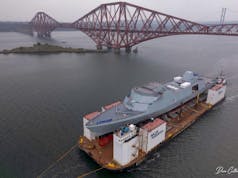

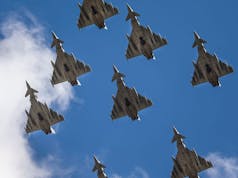
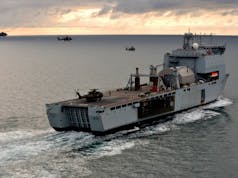
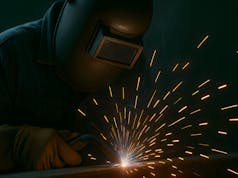

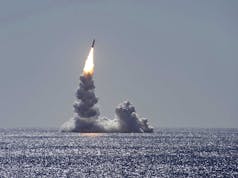

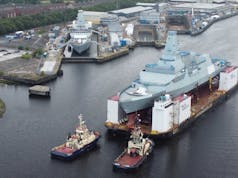


A bit surprised phalanx is still around, I know it’s been in service for ages but I was shocked to see that wiki says it was designed in 1969! Is Phalanx still up to the job of shooting down modern missiles?
The maximum range is badged as 5.5km, at hypersonic velocities this is only 1 or 2 seconds to acquire, direct and engage. A missile detonation would also create a hypersonic shrapnel field that could easily hit the ship. Are there any examples of Phalanx successfully defeating a hypersonic threat?
Detection range is more than that I think, it spots the missile, tracks it, then opens fire at 5.5km as you said. I don’t think a phalanx has actually been used in combat against the sort of missile it was designed for, and the obvious difficulty of developing a hypersonic target drone means none of that either.
The whole ‘hypersonic shrapnel field’ is a bit of an issue, I believe that’s why the RN is moving towards 57- and 40-mm with more range and precision. The 3P ammo also tries to divert the missile off course by destroying sensors and control surfaces rather than blasting it apart like Phalanx
Hypersonic weapons are no moving at hypersonic speeds in the terminal stage of flight, they must slow down at sea level or burn up.
Phalanx is the last line in a series (theoretical, ffbnw or actual) of layered defences, its role is perfectly suited for this.
Yes, phalanx is an excellent choice if you are talking purely in terms of shooting down a supersonic missile. But that’s not the only thing the secondary guns of modern ships have to defend against. The 40mm can do all of these tasks equally well:
Destroying small boats
Destroying UAVs
Defending against missiles
Traditional AA
Whereas the phalanx is a 6 tonne dumb one-trick pony
40mm rate of fire concerns me when milliseconds count. For an incoming “threat”, hundreds of rounds of tungsten with mm accuracy is not to sniffed at.
Is it mm accuracy though? I thought that was part of the point of 40mm, it was more accurate and precise so that it took fewer rounds for a kill
To me, videos of phalanx always look slightly desperate, it’s always a last ditch attempt to save the ship as range is so small. 40mm gives that little more breathing room with pre-fragmentation providing the “cone of tungsten” that is the point of phalanx
Agreed to a degree but lets see how many 3P 40mm rounds the RN are allowed to buy, as they are very expensive, and to few rounds on ship and in store will be detrimental to the whole concept of the all singing and dancing 40mm. Great and innovative idea for the RN, the 40 and 57mm but will the penny pinchers ruin it. Cheers.
I wonder how the cost of 40mm 3P Rounds compares with the 40mm CTA Round the Thales RapidFire uses,which could make another option regarding CIWS and would tie in with our investment in the System.
Hey Airborne, stick you head into the latest article about Paras getting new packing subcontractors for parachutes, some little weeny thinks you need defending from my banter.
Observed and replied mate 😇👍
Layered responses?
What do you mean?
Aster 20-150km
CAMM 3-35 km
CIWS 0-5 km but phalanx only really does up to 2 km
The RN should use CAMM to its full potential as an anti-missile point/small area defence weapon and clear up the gun CIWS for anti-swarm role
Sorry hadn’t read comment below
Agree we should be replacing the Phalanx with 40mm. However the move may not be that simple… Phalanx is non-deck penetrating.. the 40s are deck penetrating. It is also noteworthy that the USN are moving more to point defence missiles rather than guns because they offer greater range against faster targets. However many RN ships have Sea Ceptor that can fill such a role. So having a 40mm gun is useful especially against a wide range of targets both air and surface. However in the future a Directed Energy Weapon may fill the Phalanx role.
40s not necessarily deck penetrating, it just reduces ammo
Phalanx wwould get more ammo with deck penetrating as well but nobody does it
I also think in future that for the type 83 era the DEWs will replace the super close in, anti-missle or UAV aspect of CIWS but the anti-boat, traditional AA will still fall to larger guns
Would be nice to see a couple of 57mms on Type 83 for this reason
Russia and China don’t have genuine hypersonic weapons
We hope
How would you define a Hypersonic Weapon ?.
Weapon or missile? Missile it’s a missile capable of manoeuvre or guidance at more than Mach 5. The manoeuvring bit is because ballistic missiles travel terrifyingly fast at re-entry but are at that point functioning as a giant artillery shell
On both points China has the DF-ZF and Russia has the Avangard so id say they do exist.
Yet.
Exactly this.
It is also more than useful against drones, dumb bombs and boat swarms.
So it has a very good place in a layered threat response.
It is surely expecting too much of Phalanx that it could shoot down hypersonic missiles, even if they had slowed during their terminal phase. But how many hypersonic missiles would our enemies use against our naval vessels?
Phalanx is arguably the most important. System used by the RN without it many ships would be completely undefended. We .must strive to equip the RN with the very best CIWS there is.
Agreed.
Which is why it is part of a many layered system.
For RFA phalanx is the way to go, but for navy things that already have multi-million pound Combat Management Systems I think “the very best CIWS there is” needs some sort of link to the outside world.This is the problem the Russians are having with multiple radars that can’t work together to launch multiple systems
Perhaps the best thing for fleet air defence would be to get CEC fitted for the destroyers?
Why?
CEC was an answer to a problem that existed years ago using semi active homers. It has to a large extent been overtaken by technology and has now morphed into Data Fusion.
You dont fire a missile at a target you fire at a future interception point. Once at that point RN missiles go active and hunt down the target themselves. SM2 systems cannot do that. They require a tracker illuminator to light up the target.
You need an input into the command system/missile system that has a target track. Once you have that you calculate future interception point and fire. You update the missile with future interception point via data link as it changes.
The data for the calculation can come from EW, Radar or LINK (Various).
ah my bad I was under the impression that CEC was the data link passing and providing the interception points (something I thought it was completely insane that they wouldn’t have, perhaps they intended to pass around thumb drives via Lynx? 🤭)
So actually it’s a way of using the radar on one ship to guide a SARH missile from another ship?
Yes like the carrier that only have 3 Phalanx instead of the designed number of 4 and was not given it 30mm guns and no Sea Ceptor. It is the least well defended modern carrier in terms of selfdefence.
That’s the UK government for you 🙄
I got a chance to get on board HMS Defender in May when it visited Liverpool. I love that it had the slogan ‘If it flies, it dies’ on a beam door between the Phalanx guns.
I wonder how many ship’s could of been saved of we had Phalanx back in 82 Falklands conflict 🤔 🇬🇧
HMS’s Sheffield and Coventry 100%,Ardent and Antelope probably not, San Carlos Water might not have been the ideal environment for Ships equipped with CIWS.Atlantic Conveyor maybe if she was close to a Ship so equipped might have been ok.RFA Sir Galahad maybe but she was in confined waters also.
Thank you for your reply.🍺
A County Class destroyer was also hit by a land based missile but survived. Had she had Phalanx and not Sea Cat/Sea Slug she would have likely shot down the incoming missile. Phalanx was around in 1982 so why did we not buy some… i think at the time even the carriers did not have them. The RN knew that Sea Dart was not capable at low level but we did nothing to fill the capability gap. Once again I suspect it was penny pinching by the treasury.
Indeed HMS Glamorgan suffered an Exocet hit launched from Land but she survived,she turned Stern on to the threat and the Missile hit the Hangar,but lives were still lost sadly.When the Task Force sailed south they may have thought that Diplomacy might have intervened before they actually arrived in the South Atlantic and any deficiencies in Air Defence would not have been exposed.The RN knew it had two modern Missile Systems and two obsolete ones,at that time Phalanx was relatively new to service so might have been beyound the means of the Budget at the time to be bought into service,or the need for it had been identified but it was too late to do anything about it.
They very hurriedly stuck Gatekeeper on one of the carriers going down, I read that somewhere
Not true.
HMS Illustrious R06 was rushed out of build and hurriedly sent down to the Falklands to relieve Invincible and she did indeed have Phalanx fitted which i didn’t know so apologies for that.